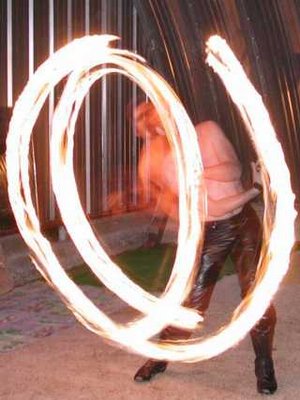Fire dancing
|
|
FlamingPoi.jpg
AnnanStaff1.jpg
Firedancing (also known as "fire twirling," "fire spinning," or "fire manipulation") is a group of circus-art disciplines that involve manipulation of objects on fire. Typically these objects have one or more bundles of wicking, which are soaked in fuel and lit.
Some of these disciplines are related to juggling, and there is also an affinity between firedancing and Rhythmic gymnastics. Firedancing is often performed to music.
Fire apparatus can be roughly divided into two groups: rhythmic and non-rhythmic. Rhythmic apparatus are twirled or manipulated in circular or other rhythmic/repetitive patterns; non-rhythmic apparatus do not have such clearly defined motions.
Some rhythmic fire apparatus are:
- poi (a pair of chains with wicks on one end);
- staff (single or double);
- batons;
- fire sticks (like devil sticks, with wicks on both ends of the center stick);
- meteors (a long rope with wicks on both ends);
- torches (swung like Indian clubs or tossed end-over-end like juggling clubs);
- fire-knives.
Some non-rhythmic fire apparatus are:
- fans;
- finger wands;
- palm torches.
The typical construction of fire performance tools involves a metallic structure with wicking material made from fiberglass, cotton, or Kevlar blended with fiberglass, Nomex, and other para-aramids. Kevlar-blend wicks are the most common, and are considered standard equipment in modern fire performance. Though most wick suppliers refer to their wick simply as Kevlar, almost no suppliers sell a 100% Kevlar wick, which is both incredibly expensive, and not particularly absorbent.
A typical poi construction would consist of a single or double looped handle made of webbing, Kevlar fabric, or leather. This is connected to a swivel and a length of chain or cable. This chain or cable then connects to another swivel, and then to the wick, which is made out of tape wick (a wide, flat webbing made of wick material), or rope wick. The wick material is typically folded or tied to a central core in either a knot or lanyard-type fold.
The chain or cable can be anything from stainless steel wire rope (preferred by some for its low cost, light weight, incredible strength, and almost invisible profile), to dog chain (preferred by some for its heft and low cost), to industrial ball chain, which is the most common chain for fire performance equipment. Made out of nickel-plated steel, stainless steel, or black-oxide brass, ball chain in the #13 to #20 size ranges provides excellent strength, a fluid feel, and great tangle prevention. Since every link on the chain swivels, one can eliminate dedicated swivels from a design, and body wrapping and chain wrapping moves become much easier. Extra cost and a higher weight to durability ratio are the biggest downsides to ball chain.
Typical fire performance fuels include:
- White gas, a.k.a. Coleman fuel, naphtha, or petroleum ether: This hot, volatile fuel is popular because it is easy to light, burns brightly, evaporates cleanly, and does not leave smoke or residues on wicks and bodies. However, it burns hot and quick, limiting the burn time, and potentially increasing the risk of burns.
- Kerosene or jet fuel: This is a popular fuel due to its low cost and relative safety. It is very difficult to light, meaning that smoldering wicks can actually be extinguished by dunking them in kerosene. It is popular because of its low cost, relative safety, and long burn times. Some performers do not like it because of its dim, smokey flame and slippery residue. A common fuel is made by using a 50/50 mix of white gas and kerosene, which offers some of the benefits of both fuels.
- Lamp oil, a.k.a. liquid paraffin: Lamp oil is an oily, non-volatile fuel. It has many of the same properties as kerosene, including its long burn time and high flash point, but it produces much less smoke. Lamp oil is fairly expensive as a fuel and difficult to light alone; so, like kerosene, it is often mixed with white gas.
- Alcohol, a.k.a. denatured alcohol, methylated spirits, meths: Alcohol fuels are usually ethanol with methanol, acetone, gasoline, or other denaturing agents added. The denaturing agents provide odor and toxicity to discourage consumption of the fuel, and may lower the cost and adjust burning and vaporization properties for industrial reasons. Denatured alcohols can be up to 95% ethanol, or as little as 50%. Contact the manufacturer of the fuel and request an MSDS sheet indicating the exact mixture. The fuel burns fairly hot, and is volatile, meaning it readily releases flammable vapors. The flame is blue to orange, depending on methanol content, and fairly dim. However, when mixed with chemicals such as lithium chloride, copper chloride and boric acid, various colors of flame can be created. Lithium compounds produce pinks, copper compounds produce greens and blues, and boric acid produces green. Other chemicals may produce other colors, and performers often experiment with various choices. Use of chemicals like these may produce some toxic vapors, and have a tendency to destroy wicks; please use caution.
- Biodiesel: Biodiesel is a fuel produced by refinement of vegetable oil (used or virgin), producing glycerin and biodiesel. The fuel is designed for use in diesel vehicles, but is a fairly safe and practical fuel for fire performance. Like kerosene, it is difficult to light by itself, and produces a dim, long-lasting flame that may smell a bit like French fries, depending on the source. It is often mixed with white gas to produce an easy-to-light, long-burning fuel. If you live in a town with a biodiesel cooperative, it can be quite cheap as well.
See also
External links
- Home of Poi (http://homeofpoi.com/)
- Fire Dancing (http://www.fire-dancing.com/) World-wide resources for trainers & performers

